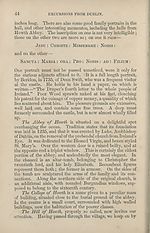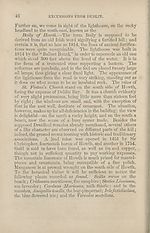Download files
Complete book:
Individual page:
Thumbnail gallery: Grid view | List view

HOWTH.
45
the road to the right, and looking back at intervals, get a fine
view of Ireland’s Eye and Lambey islands, with the village of
Howth in the foreground; all the prettier for being partially
shrouded with trees. Continuing this walk, we come in sight
of the rugged summits of Ben Edar, the highest point of which
is 563 feet above the sea level. The steep rocks of Carricmore
overhang the beautiful grounds of Howth Castle, and afford
an extensive view of the coast, with a foreground of heather.
At the foot of the rocks is an ancient cromlech, consisting
of a huge oblong stone, about fourteen feet by twelve, supported
on a number of others. Some of the supporting stones are
still seven feet in height. Writers are at variance regarding
the origin of this relic—some asserting that it was originally
connected in some mysterious manner with a druidical temple.
The more generally received opinion is, that the cromlech was
part of the sepulchral monument raised by the ancient inha¬
bitants over their departed chiefs. That it was, in fact, nothing
more than a frame-work to protect the contents of the tomb
from the pressure of the immense mass of stones piled around
and above it in order to form a cairn. Taking this view of
the subject, we must suppose that, in the course of time, the
stones have been gradually removed from the cairn, leaving
only the internal supports. An explanation, if not as reliable,
yet more amusing, is the legend current among the natives, that
the huge mass was pitched into its present position by the
renowned giant Fin MacCoul, when fighting with a Danish
warrior. The new road, so named by way of distinguishing
it from all others, is generally followed by travellers, affording
a fine succession of marine views. Passing by this way the
beautiful bay of Balscadden, a favourite bathing-place, we
come to Puck’s Rocks, situated on the north-east corner of the
peninsula. A deep fissure separates the rock. Near the
summit of the deep chasm is a rude representation of a human
figure. This figure, tradition tells us, is the petrified remains
of an evil spirit, who used to plague the good Saint Nessan,
when he lived on Ireland’s Eye. On one occasion, the saint
was reading the much venerated book of Howth, on the
approach of his fiendish enemy; and raising the precious
volume, struck the intruder so forcibly with it, that he was
knocked right across the water into the rock, which split into
that yawning chasm in order to receive him. A little further
on is the unlucky Castlena rock, on which the Victoria struck.
45
the road to the right, and looking back at intervals, get a fine
view of Ireland’s Eye and Lambey islands, with the village of
Howth in the foreground; all the prettier for being partially
shrouded with trees. Continuing this walk, we come in sight
of the rugged summits of Ben Edar, the highest point of which
is 563 feet above the sea level. The steep rocks of Carricmore
overhang the beautiful grounds of Howth Castle, and afford
an extensive view of the coast, with a foreground of heather.
At the foot of the rocks is an ancient cromlech, consisting
of a huge oblong stone, about fourteen feet by twelve, supported
on a number of others. Some of the supporting stones are
still seven feet in height. Writers are at variance regarding
the origin of this relic—some asserting that it was originally
connected in some mysterious manner with a druidical temple.
The more generally received opinion is, that the cromlech was
part of the sepulchral monument raised by the ancient inha¬
bitants over their departed chiefs. That it was, in fact, nothing
more than a frame-work to protect the contents of the tomb
from the pressure of the immense mass of stones piled around
and above it in order to form a cairn. Taking this view of
the subject, we must suppose that, in the course of time, the
stones have been gradually removed from the cairn, leaving
only the internal supports. An explanation, if not as reliable,
yet more amusing, is the legend current among the natives, that
the huge mass was pitched into its present position by the
renowned giant Fin MacCoul, when fighting with a Danish
warrior. The new road, so named by way of distinguishing
it from all others, is generally followed by travellers, affording
a fine succession of marine views. Passing by this way the
beautiful bay of Balscadden, a favourite bathing-place, we
come to Puck’s Rocks, situated on the north-east corner of the
peninsula. A deep fissure separates the rock. Near the
summit of the deep chasm is a rude representation of a human
figure. This figure, tradition tells us, is the petrified remains
of an evil spirit, who used to plague the good Saint Nessan,
when he lived on Ireland’s Eye. On one occasion, the saint
was reading the much venerated book of Howth, on the
approach of his fiendish enemy; and raising the precious
volume, struck the intruder so forcibly with it, that he was
knocked right across the water into the rock, which split into
that yawning chasm in order to receive him. A little further
on is the unlucky Castlena rock, on which the Victoria struck.
Set display mode to:
![]() Universal Viewer |
Universal Viewer | ![]() Mirador |
Large image | Transcription
Mirador |
Large image | Transcription
| Antiquarian books of Scotland > Ireland/Irish > Black's guide to Dublin and the Wicklow mountains. With plan of Dublin > (61) |
|---|
| Permanent URL | https://digital.nls.uk/120663724 |
|---|
| Description | Thousands of printed books from the Antiquarian Books of Scotland collection which dates from 1641 to the 1980s. The collection consists of 14,800 books which were published in Scotland or have a Scottish connection, e.g. through the author, printer or owner. Subjects covered include sport, education, diseases, adventure, occupations, Jacobites, politics and religion. Among the 29 languages represented are English, Gaelic, Italian, French, Russian and Swedish. |
|---|

